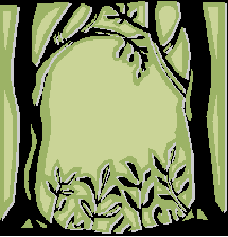Uña de Gato (Uncaria tomentosa)
Uncaria tomentosa, or uña de gato (cat's claw), is the best known of
the Peruvian medicinal plants and the most frequently represented in the
literature. A woody vine containing a lear watery sap, it grows wild in
the upper Amazon region of Peru and neighboring countries, and can reach
several inches in diameter and 1,000 feet in height. The part used medicinally
is the inner bark of the vine from which a boiled decoction is made or extracts
produced. In recent years, extracts of the root have also been prepared
commercially. Uña de gato is considered a sacred plant among the Ashaninkas
and other indigenous Peruvian Amazonian tribes such as the Campo. According
to the Austrian investigator Klaus Keplinger, the herb serves as a means
of "regulating the physical and spiritual worlds" for these tribal groups.
The chemical composition of uña de gato includes 17 different alkaloids,
quinovic acid glycosides, tannins, flavonoids, sterol fractions, and other
compounds Indole alkaloids possess an indole ring in their structure, a versatile
heterocyclic structure discovered in 1866, and found in a considerable number
of medicinal products from plants The pharmacological actions of uña de
gato include antioxidant properties, anti-inflammatory activity, immunomodulation,
cytoprotection, antimutagenic properties, and antihypertensive effects,
as well as ossible prevention of cerebral ischemia. Immunomodulating activity
includes suppression of NF-kappa B, enhancement of B- and T-lymphocytes,
stimulation of phagocytosis, and enhancement of IL-1 and IL-6. In a Peruvian
study on rats, the investigators found that phagocytosis was increased when
an extract was administered at a dose of 400 mg/kg. In a study by Sandoval
et al a water extract showed cat's claw to be, "a remarkably potent inhibitor
of TNF-a. The primary mechanism for cat's claw's anti-inflammatory action
appears to be immunomodulation via suppression of TNF-a synthesis." A 1998
study showed that pentacyclic alkaloids weakly activated human B- and T-lymphocytes,
and that tetracyclic oxindole alkaloids reduced the activity of pentacyclic
oxindoles. In another recent study, Swedish researchers using an aqueous extract
treated radiation-induced DNA damage in rats. Results indicated "significant"
repair of DNA breaks. Based upon this research, it is generally accepted that
the pentacyclic oxindole alkaloids are the principle immunomodulating agents
in uña de gato.
Clinical Applications and Dosage
Uña de gato has broad therapeutic potential, including the treatment
of chronic viral infections, viral and bacterial co-infections in AIDS,
cancer, the prevention of radiation damage, nd in inflammatory disorders.
Although there are no randomized controlled trials or published human outcome
studies, some conditions reportedly improved by uña de gato include osteoarthritis,
rheumatoid arthritis, rostatitis as a non-specific immuno-modulating agent
in viral illnesses and cancer,81 and it may also have potential as an immunomodulating
adaptogen in aging.
Although the field of study in immune enhancing compounds is relatively
new, natural products from plants represent a rich and promising source
of novel molecules with immunomodulating propertiesPlants are also a promising
source of systemic broad-spectrum antivirals that may cause less damage
to host cells infected by chronic viruses, such as hepatitis C, than do
pharmaceuticals. Topical antiviral substances are also important areas of
study for the treatment of viral lesions such as in herpes simplex virus,
and plant-based substances offer promise as virucidals.The most promising
of the currently known Amazonian herbs are Uncaria tomentosa and Croton
lechleri, with Uncaria the more studied. Both plants have similar therapeutic
properties, including anti-inflammatory, antiviral, antibacterial, antioxidant,
and immunomodulating activity. By current investigations, the therapeutic
differentiation between the two is that uña de gato appears to have more
immune-stimulatory effects with sangre de grado demonstrating more antimicrobial
activity. However, with a few exceptions, the majority of studies have been
in vitro or in animal models, with weak to moderate immunomodulating and
antiviral effects. There is no overwhelming evidence to support the public
perception of these herbs as potent immune stimulants, although they appear
to be beneficial and safe, non-specific immunomodulating botanicals



